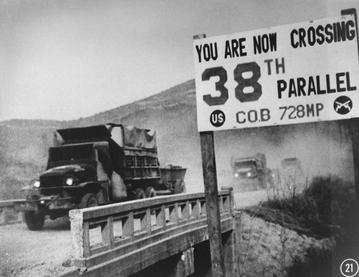
Why are the two Koreas still at war? The two Koreas are still at war because they didn’t sign a peace treaty in 1953 when the Korean War ended. Fighting could technically break out at any time, although it is fairly unlikely. The reason they didn’t sign a peace treaty is surprisingly because of the South Koreans and not the North.
The Korean War started on June 25th, 1950. The beginnings of the war go back long before this, though. The Korean Peninsula was occupied by the Japanese from 1910 until the end of World War 2 in 1945. At the end of the war, the USA and the USSR vied to occupy the countries that Japan and Germany had been forced out of. Across Europe, this was clearest in Germany, where it was divided into East, controlled by the USSR, and West, controlled by the USA and the allies. The Berlin Wall through the city was probably the most famous symbol of this east-west divide. The same thing happened in Korea. The USA occupied the South and the USSR occupied the North, divided along the 38th parallel. The 38th parallel is called “parallel” because it closely parallels the circle of latitude at 38 degrees north. It doesn’t perfectly parallel the line of latitude and actually crosses it at one point.
North Korea, under the influence of the USSR, became a communist state pretty quickly. The USA was very alarmed by all of the countries across the world that were becoming communist and they saw it as a threat. This would last through the next several decades and governed a lot of international affairs. The USA’s presence in South Korea was thought to be enough of a deterrent to keep the north and south divided along the 38th parallel. That turned out not to be current and North Korea invaded into South Korea on June 25th, 1950. They wanted to reunite the Korean peninsula and make one communist state. This took the US by surprise and the North Korean troops very rapidly pushed down into South Korea, capturing Seoul. By mid-August 1950, they had almost captured the entire peninsula and the few US forces and South Korean forces were pinned in the southwest of the country. In mid-September, more US forces arrive and they land at Incheon before rapidly reversing the course of the war and pushing the North Korean forces back up the peninsula.
By November 1950, the South Korean troops, supported by the US, had pushed the North Korean forces back to the northernmost point of Korea, almost on the border with China. China didn’t like the idea of a unified Korea supported by the US on its border and Chinese troops flooded into North Korea to help the North Korean troops. Through the winter and into early 1951, they pushed the South Korean and US forces back into South Korea. The US counterattacked and pushed back. By April of 1951, they had returned to the 38th parallel with North Korea and China, backed by the USSR, on the north side, and South Korea with the USA on the south side. They moved north and south very slightly, but pretty much stayed on that line for the next two years. It was a war of attrition and the only thing that changed before the end of the war was the number of causalities. By the end of the war, 1.5 million North Korean, Chinese, and USSR soldiers had died and almost 900,000 South Korean and US forces had died. Both sides knew that the war was going nowhere and they started to think about ending it. It turned out later that General MacArthur, the head of the United Nations troops, had pushed hard to use nuclear weapons but, fortunately, he was never given permission.
Talks about an armistice had been going on since almost the beginning of the war. They picked up pace in 1951 and continued on and off through the next two years. The biggest problems were trying to agree on how to repatriate prisoners of war and where the line between the two countries should be drawn. It was difficult to get an agreement and it looked like the armistice would never be signed until suddenly Joseph Stalin died in March 1953. The new USSR government was not interested in prolonging the war and looked for a quick solution. Mao Zedong and China wanted to continue, but without the support of the USSR, it would be difficult. This brought both sides back to the table and the armistice was signed on 27th July, 1953 at 10 am. This ended the fighting, but it didn’t end the war.
The next logical step after the armistice was signed was a peace treaty, but there were so many problems that they couldn’t work out. We might think that it would be North Korea that would refuse to sign a peace treaty, but it was actually the president of South Korea, Syngman Rhee, who refused to sign anything. He couldn’t bear the thought that the Koreas were not united. There was also the problem of prisoners of war. The North Koreans refused to return a lot of prisoners and a lot of prisoners held by the South didn’t want to return. These and other things caused a breakdown in talks and by the end of 1954, it looked impossible that there would be a peace treaty. The armistice still holds, but there is still no peace treaty and the two countries are technically still at war. And this is what I learned today.
If you liked this, try these:
Sources
https://www.history.army.mil/reference/Korea/kw-chrono.htm
https://en.wikipedia.org/wiki/Korean_Armistice_Agreement
https://www.eisenhowerlibrary.gov/research/online-documents/korean-war
https://www.iwm.org.uk/history/a-short-history-of-the-korean-war
https://www.history.com/news/korean-war-peace-treaty-pows
Image By Unknown, probably US Military – https://time.com/3915803/korean-war-1950-history/, Fair use, https://en.wikipedia.org/w/index.php?curid=56833630
